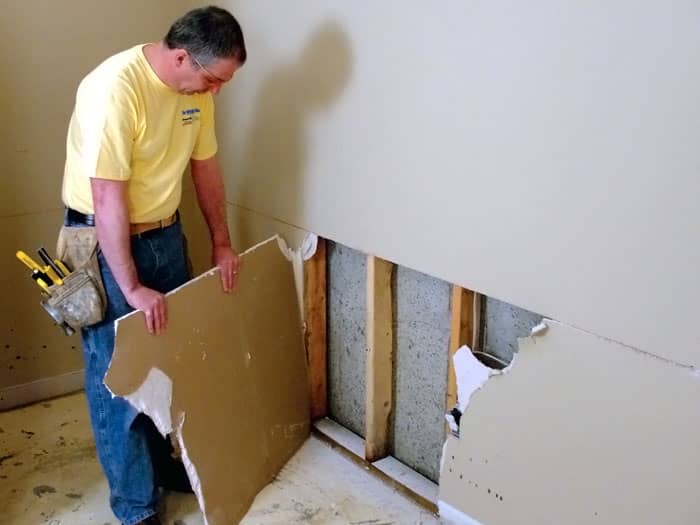Best Basement Waterproofing for Dummies
Best Basement Waterproofing for Dummies
Blog Article
The Ultimate Guide To Best Basement Waterproofing
Table of ContentsThe Definitive Guide to Best Basement WaterproofingLittle Known Questions About Best Basement Waterproofing.Best Basement Waterproofing for BeginnersA Biased View of Best Basement WaterproofingOur Best Basement Waterproofing Ideas
uses excavation techniques toward the bottom of the structure's structure. involves getting rid of dampness after it has actually gotten in the cellar. AdvantaClean's experienced professionals and technicians will certainly situate the water source. If wall or slab splits exist, we will certainly infuse polyurethane and epoxies right into the splits and secure the concession, protecting against additional dampness from going into.Appropriate grading around the home to route moisture far from the framework. Installing, fixing, or cleaning seamless gutters and downspouts. Inside or outside waterproofing with filler, sealer, and/or water-proof paint. Setting up basement ventilation systems, conditioning systems, or basement dehumidifier systems to get water out of your cellar. Selecting AdvantaClean's basement waterproofing services is an efficient way to treat moisture and avoid mold and mildew from endangering the framework of your home and the health of your family.
If there's condensation on the exterior of the foil, you have high humidity in your basement. If the aluminum foil has condensation on the inside surface area (following to the wall surface), the dirt around your residence may be naturally damp from a high water table or inadequate soil drainage.
You can waterproof just your interior walls, which might address the issue. Or you can waterproof your outside wall surfaces, which is a far better bet but more costly. Below's the inside story on the different types: These thick layers are cement-like. Once they dry, they stick permanently to concrete and stonework wall surfaces.
Best Basement Waterproofing - The Facts
Swirl the brush at the last phase of application to give the wall an eye-catching, ended up appearance. Concrete waterproof layers can not be related to previously painted surface areas; inspect the tag. A 5-gallon pail costs concerning $60. Likewise recognized as densifiers, they appropriate only for wall surfaces that haven't been repainted or sealed.
However you brush, roll, or spray it on far more thickly one gallon covers simply 75 square feet, not the 300 square feet typical with conventional paint. Waterproof paint is fine for do it yourself application. You can use it over repainted surface areas, and paint over it once it's cured (one gallon expenses $37).
It can set you back $10,000 to $15,000, depending on the work required (Best Basement Waterproofing). Outside waterproofing involves excavating useful content all around the house to the complete depth of the structure wall surfaces, then setting up a waterproof layer or membrane layer covered by drain panels.
Get This Report about Best Basement Waterproofing
A basement without waterproofing is kind of like that. Your basement does not want to go with a rainstorm without correct protection just as much as you do not want to.

Outside waterproofing is a waterproofing approach that entails sealing your home from the exterior. It's kind of like a moat around a castle. It entails digging a trench around your whole residence down to the foundation (about 8 to 10 feet down). The structure wall surfaces are after that cleaned up, sealed, and covered with a water-proof membrane or sealant.
Not known Facts About Best Basement Waterproofing
It's a much more engaged procedure that needs digging up your backyard, which is costly and lengthy. Outside waterproofing entails removing every little thing surrounding your home, including decks, driveways, pathways, landscaping, AC units, decks, and so on. If any of the job was done inaccurately and water is still entering your basement, there isn't much you can do to deal with or fix it.
Interior basement waterproofing includes waterproofing from the inside. Any kind of water that leakages right into your cellar is redirected before it touches your floor.
It's an efficient method to waterproof your cellar. The downside of interior basement waterproofing primarily concerns the installation process. This technique needs kept products, furnishings, and these details built-in shelving or closets to be moved from touching the cellar wall surfaces. And throughout setup, your basement can not be used. The most significant difference in between both approaches is this: Exterior waterproofing is a preventative option and interior waterproofing is a rehabilitative option.
The Ultimate Guide To Best Basement Waterproofing
To conclude, exterior and indoor basement waterproofing are both effective approaches of securing your home from water damage. Outside waterproofing creates an obstacle that avoids water from entering your home, while interior waterproofing reroutes water that does enter your home. And it is very important to note that exterior waterproofing is a costly and disruptive installation process when contrasted to indoor waterproofing.
Whichever method you choose, make sure you pick a reputable and trustworthy service provider for the work. If you have any kind of concerns regarding basement waterproofing, please reach out to us.
You can submit our kind below. Best Basement Waterproofing, begin a conversation in the lower right-hand corner, or call us at 1-800-827-0702
Report this page